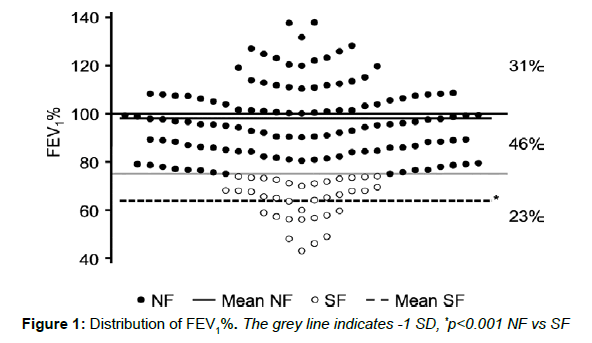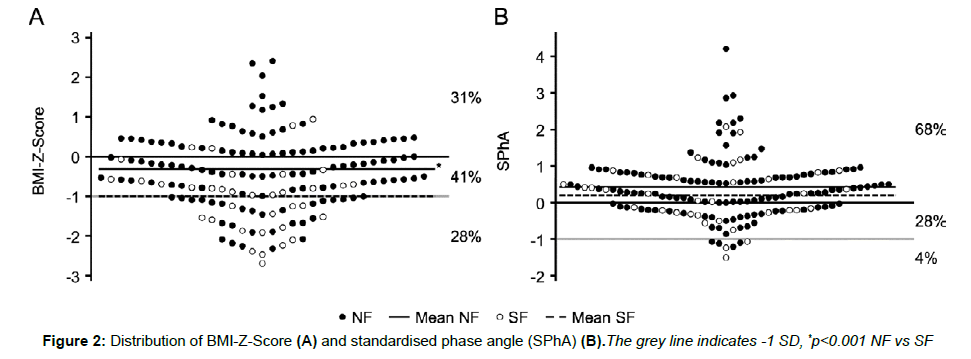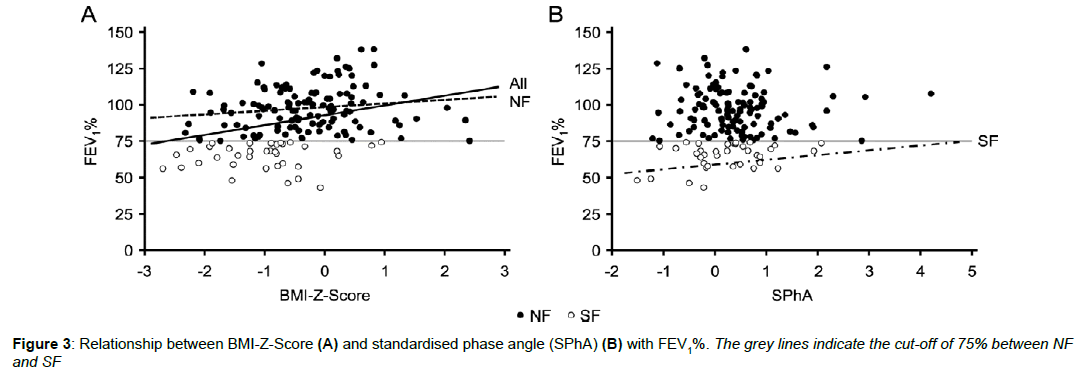Research Article, J Clin Nutr Metab Vol: 2 Issue: 1
Relationship between Bio-Impedance Phase Angle and Lung Function in Children and Adolescents with Cystic Fibrosis
Momme Kück1*, Lothar Stein1,2*, Carina Hoyng2, Lena Grams1, Arno Kerling1, Katrin Schlüter2 and Sibylle Junge2
1Hannover Medical School, Institute of Sports Medicine, Germany
2Hannover Medical School, Paediatric Pneumology and Neonatology, Germany
*Corresponding Author : Lothar Stein
Hannover Medical School, Institute of Sports Medicine, Carl-Neuberg-Strasse 1, 30625 Hannover, Germany
Tel: +49-511-532-9217
Fax: +49-511-532-8199
E-mail: stein.lothar@mh-hannover.de
*Momme Kück and Lothar Stein contributed equally and share first authorship
Received: January 02, 2018 Accepted: January 19, 2018 Published: January 26, 2018
Citation: Kück M, Stein L, Hoyng C, Grams L, Kerling A, et al. (2018) Relationship between Bio-Impedance Phase Angle and Lung Function in Children and Adolescents with Cystic Fibrosis. J Clin Nutr Metab 2:1.
Abstract
Objectives: Pulmonary dysfunction is the main cause of mortality in cystic fibrosis and has a close relationship with malnutrition. Therefore, early detection of malnutrition is essential to starting nutritional interventions as soon as possible. Routinely BMI-Z-Score is used as a marker of malnutrition. To evaluate whether body composition may be a better predictor of malnutrition, the standardised phase angle (SPhA) is determined for comparison.
Methods: We divided 156 children and adolescents with cystic fibrosis according to the severity of pulmonary dysfunction into normal dysfunction (NF n=120; FEV1% ≥ 75%) and severe dysfunction (SF n=36; FEV1%<75%) groups, using FEV1% measured by spirometry for classification. To assess nutritional status, we calculated the BMI-Z-Score and determined the SPhA with bio-impedance analysis.
Results: An intraclass-correlation showed no agreement between BMI-Z-Score and SPhA. Stepwise multiple regressions with FEV1% as the dependent variable showed that BMI-Z-Score was the only significant predictor in NF and accounted for 16% of the observed variance. In SF, 34% of the variance was explained by SPhA.
Conclusion: SPhA may be a better prognostic indicator of severe pulmonary dysfunction in children and adolescents with cystic fibrosis than BMI-Z-Score. Therefore, the early recognition of malnutrition by SPhA may improve clinical outcomes through earlier initiation of nutritional interventions.
Keywords: Bio-impedance; Cystic fibrosis; Lung function; Paediatrics; Phase angle
Abbreviations
NF: Normal Pulmonary Dysfunction; Pha: Phase Angle; SF: Severe Pulmonary Dysfunction; Spha: Standardised Phase Angle (Spha)
Keynotes
The standardised phase angle may be a better prognostic indicator of severe pulmonary dysfunction in children and adolescents with cystic fibrosis than BMI-Z-Score.
The early recognition of malnutrition by the standardised phase angle may improve clinical outcomes through earlier initiation of nutritional interventions.
Introduction
Cystic fibrosis (CF) is the most common autosomal recessive genetic disease in the white population, occurring in approximately 1 in 3000 births [1]. It is caused by mutations in the cystic fibrosis transmembrane regulator (CFTR) gene, which functions primarily as a chloride channel and is expressed in many epithelial and blood cells. Therefore, CF leads to a complex multisystem disorder affecting various cells, tissues and organs, such as secretory cells, the sinuses, lungs, pancreas, liver, and reproductive tract. The infection and inflammation of the lungs is the main cause, with at least 80% mortality [2]. However, malnutrition is the earliest and most noticeable manifestation and has a close relationship to lung disease. So increases the pulmonary disease energy expenditure and concurrently reduces appetite. Furthermore, good nutritional status is associated with good lung function [3]. In this regard, an early detection of malnutrition is essential to starting nutritional interventions as soon as possible.
Normally, nutrition status in children and adolescents with CF is determined by anthropometric measurements of height and weight expressed as a Z-Score using age-related reference values (i.e., the body mass index (BMI) Z-Score). However, these measurements show a lack of accuracy in detecting malnutrition in children and adolescents with CF compared to total body potassium [4] or skinfold thickness measurements [5]. Therefore, body composition seems to be a better predictor of malnutrition. Dual-energy X-ray absorptiometry is highly reliable and widely used to determine body composition. Nevertheless it is very expensive and increases the already high X-ray exposure of children and adolescents with CF [6]. The less expensive bioelectrical impedance analysis, as a non-invasive and easily performed method, can routinely be used to assess body composition. Studies comparing dual-energy X-ray absorptiometry with bioelectrical impedance analysis measurements reported both high correlations for fat free mass and fat mass in patients with CF and large variability on individual level [7,8]. One possible explanation seems to be the absence of CF-specific equations to determine body composition from bioelectrical impedance analysis. Thus, the raw bioelectrical impedance analysis parameter phase angle (PhA) calculated from resistance and reactance is more promising because it is a marker of clinically relevant malnutrition in different clinical conditions, like cancer [9], chronic liver disease [10], or in children and adolescents undergoing Hematopoietic Stem Cell Transplantation [11]. Additionally, PhA has been shown to be a good predictor of mortality and morbidity in HIV/AIDS [12], cancers [13], liver cirrhosis [14], and dialysis [15]. When PhA is also transferred in a Z-Score with age-, sex- and BMI-related reference values, the resulting standardised phase angle (SPhA) is considered a more suitable predictor of malnutrition than PhA [16]. Consequently, we determined the BMIZ- Score and SPhA in children and adolescents with CF and analysed their association with the severity of pulmonary dysfunction.
Patients and Methods
Patients and study design
In this prospective, cross-sectional study, we examined 156 children and adolescents with CF aged 6-18 years, who were randomly recruited from the Children’s Hospital CF-Ambulance of the Hannover Medical School, Germany. During their outpatient visits, the patients routinely underwent several tests, including anthropometric measurements, bio-impedance analyses, spirometry and exercise testing. The inclusion criteria were as follows: CF diagnosed to international standards [17], age between 6 and 18, accomplished anthropometric measurements, bio-impedance analysis, and spirometry. Patients with lung transplantation were excluded.
The study was approved by the Ethics Committee of the Hannover Medical School, and the parents or legal guardians of all patients gave their written consent.
Anthropometric measurements
Weight was measured with an electronic scale (seca 910, seca, Hamburg, Germany), to the nearest 0.1 kg, and height was determined with a stadiometer (Ulmer stadiometer, Busse Design+Engineering GmbH, Elchingen, Germany), accurate to 0.1 cm. The patients wore light clothing and no shoes. BMI was calculated as the ratio of weight (kg) to height (m) squared. To standardise BMI for age and sex, a BMI-Z-Score was determined for each patient according to Flegal et al. [18]. Additionally, we determined BMI percentiles using age- and sex-matched CF peers as a reference [19].
Bio-impedance analysis
Whole body (tetrapolar hand-to-foot technique) bio-impedance analysis (BIA 2000-M, Data Input, Darmstadt, Germany) was performed to determine the PhA from resistance and reactance at multiple frequencies (5, 50, 100 kHz). NutriPlus Software (Version 5.4.1, Data Input, Darmstadt, Germany) was used for analysis. The SPhA was calculated from reference values as follows: SPhA=(PhA– mean PhA)/standard deviation PhA, where mean PhA and standard deviation PhA were derived from sex-, age-, and BMI-stratified reference values [20].
Spirometry
To classify pulmonary function, we measured the forced expiratory volume at 1s (FEV1) with a spirometer (Jaeger Master Screen, CareFusion, Wurmlingen, Germany), in accordance with the American Thoracic Society guidelines [21]. Values were expressed as a percentage of predicted values (FEV1%), according to Knudson et al. [22]. Spirometry was performed without bronchodilation.
Patients’ stratification and statistical analysis
To establish the relationship between BMI-Z-Score and SPhA and the severity of pulmonary dysfunction, patients were divided into two groups according to their FEV1%. The cut-off point between normal (NF) and severe (SF) pulmonary dysfunction was set at 75% FEV1%. The NF group consisted of 63 boys and 57 girls, and the SF of 15 boys and 21 girls.
Normal distribution was tested with the Kolmogorov-Smirnov- Test. To compare groups of NF and SF, unpaired two-sided student t-tests were performed for parametric data, and Mann-Whitney-UTests, for non-parametric data. Hedges’ g was determined to estimate the effect size. To evaluate the extent of agreement between BMI-ZScore and SPhA, an intraclass correlation was computed. To identify the relationship to the dependent variable, FEV1%, for all patients and both NF and SF, a multiple regression with the independent variables of BMI-Z-Score and SPhA was performed stepwise with the inclusion criterion of p<0.05 and an increasing p-value until a valid regression was reached. All data are given as the mean ± standard deviation. Significance was accepted as p<0.05. All tests were performed with the SPSS software (Version 24, IBM Corp., Armonk, NY, USA).
Results
Characteristics of all patients and groups of NF and SF are presented in Table 1.
| All | NF | SF | p-Value | |
|---|---|---|---|---|
| Parameter | N=156 | n=120 | n=36 | NF vs. SF |
| Age (years) | 11.3 ± 3.4 | 11.1 ± 3.4 | 12.1 ± 3.3 | 0.113 |
| Height (m) | 1.45 ± 0.19 | 1.44 ± 0.19 | 1.48 ± 0.17 | 0.275 |
| Weight (kg) | 37.4 ± 14.1 | 37.7 ± 14.5 | 36.6 ± 12.6 | 0.697 |
| FEV1% (%) | 90 ± 20 | 98 ± 15 | 64 ± 9 | <0.001 |
| BMI (kg·m-2) | 17.1 ± 2.7 | 17.3 ± 2.8 | 16.3 ± 2.2 | 0.040 |
| BMI-Z-Score | -0.5 ± 1.0 | -0.3 ± 0.9 | -1.0 ± 0.9 | <0.001 |
| BMI percentileCF | 48.0 ± 27.9 | 53.7 ± 26.9 | 29.1 ± 22.6 | <0.001 |
| PhA (°) | 5.9 ± 0.8 | 5.9 ± 0.8 | 5.7 ± 0.6 | 0.189 |
| SPhA | 0.4 ± 0.8 | 0.4 ± 0.8 | 0.2 ± 0.8 | 0.189 |
Table 1: Characteristics of all patients and the NF and SF groups.
Due to stratification, FEV1% was significantly lower in SF than in NF (p<0.001; g=2.5; Table 1). BMI (p=0.040; g=0.4) and BMI-ZScore (p<0.001; g=0.8; Table 1) were also significantly lower in SF. In comparison with CF peers, the patients in NF were over the 50th percentile, and in SF, the patients were under the 30th percentile (p>0.001; g=1.0; Table 1). PhA and SPhA showed no significant difference between the NF and SF groups (Table 1).
The distribution of FEV1% showed that 23% of all patients had an FEV1% under 75% (Figure 1): 28% had a BMI-Z-Score<-1 standard deviation from the population average, 41% had values between -1 and 0 standard deviation, and 31% had values>0 standard deviation from the population average (Figure 2A). Only 4% had a SPhA<- 1 standard deviation from the population average, while 28% had values between -1 and 0 standard deviation, and 68% had values >0 standard deviation from the average (Figures 2B).
The intraclass correlation showed no agreement (p=0.375) between BMI-Z-Score and SPhA.
Stepwise multiple regressions with FEV1% as the dependent variable showed that BMI-Z-Score was the only significant predictor in all patients and NF and accounted for 33% of the observed variance in all patients and for 16% in NF (Table 2).
In SF, 34% of the variance was explained by SPhA (Table 2). Figure 3 displayed the resulting regression for BMI-Z-Score (Figure 3A) and SPhA (Figure 3B).
| r2 | BMI-Z-Score | SPhA | total | |
|---|---|---|---|---|
| All patients (N=156) | ||||
| FEV1% | 0.33 | <0.001 | ni | <0.001 |
| NF (n=120) | ||||
| FEV1% | 0.16 | 0.090 | ni | 0.090 |
| SF (n=36) | ||||
| FEV1% | 0.34 | ni | 0.045 | 0.045 |
Table 2: Results of the multiple regressions with FEV1% as the dependent variable.
Discussion
The main finding of our study is as follows: the standardised phase angle (SPhA) may be a better prognostic indicator of the severity of pulmonary dysfunction in children and adolescents with cystic fibrosis than the BMI-Z-Score.
The BMI-Z-Score and BMI are widely used to assess the nutrition status of children and adolescents with CF. Therefore; a low BMI is associated with more severe pulmonary disease [23]. This is in line with our results, as BMI-Z-Score correlates with FEV1% in all patients. In this regard, the goal of the CF-Foundation of being over the 50th BMI percentile for healthy children and adolescents should be reached to slow the progress of lung disease [24].
Because BMI takes only weight and height into account and lacks information about body composition, such as fat mass and fat-free mass, changes in body tissue composition cannot be detected by BMI measurements. To overcome this disadvantage, several studies have examined the relationship of fat mass or fat-free mass on lung disease in children and adolescents with CF. Williams et al. [25] showed that lower fat mass in girls with CF was associated with poorer lung function, and in children and adolescents with CF, a deficiency of fatfree mass leads to reduced FEV1% [26,27].
However, determination of body composition relies on invasive methods such as dual-energy X-ray absorptiometry with small amounts of radiation or on equations based on reference values from healthy populations such as skinfold thickness measurements or bioelectrical impedance analysis. Furthermore, body composition changes occur in children and adolescents as part of normal growth making interpretation of longitudinal data complicated. In contrast, PhA is calculated solely from two raw parameters, the resistance and the reactance, obtained from non-invasive bioelectrical impedance analysis without any internal algorithm. Therefore, resistance represents the extra- and intracellular fluid, and reactance, the capacitance of the cell membranes. Thereby, a low PhA is associated with cell death or decreased cell integrity. PhA has been shown to be a predictor of mortality and morbidity in various diseases such as cancer, dialysis, or HIV [12-15]. Additionally, standardising PhA eliminates the influence of age, gender, and BMI and allows the comparison of individuals and heterogeneous populations [12] and enhances the significance as a predictor [16].
Although the SPhA has yet not been used to evaluate the association with pulmonary dysfunction in children and adolescents with CF, our results showed a relationship between SPhA and FEV1%. Additionally, multiple linear regressions revealed a possible superiority of SPhA over BMI-Z-Score in severe pulmonary dysfunction.
Due to the cross-sectional study design, further investigations are needed to show whether SPhA detects changes in nutritional status of children and adolescents with CF earlier than the BMI-Z-Score. Johansen et al. [28] showed a decreased in the phase angle in patients on haemodialysis over one year with no significant changes in body composition. As bioelectrical impedance analysis uses electrodes affixed on the skin to measure an electric current that runs through the body, the altered sodium content in the sweat of patients with CF may affect the measurement [29]. But if the conditions of measurement are standardized, the reliability of bioelectrical impedance analysis is high, making it useful for changes over time [30].
Conclusion
In conclusion, SPhA determined by non-invasive, reproducible bioelectrical impedance analysis may be a better prognostic indicator of severe pulmonary dysfunction in children and adolescents with CF than BMI-Z-Score. The early recognition of malnutrition may result in improved clinical outcomes through earlier initiation of nutritional interventions.
References
- Walters S, Mehta A (2007) Epidemiology of cystic fibrosis. London, UK.
- O'Sullivan BP, Freedman SD (2009) Cystic fibrosis. Lancet 373: 1891-1904.
- Milla CE (2007) Nutrition and lung disease in cystic fibrosis. Clin Chest Med 28: 319-330.
- McNaughton SA, Shepherd RW, Greer RG, Cleghorn GJ, Thomas BJ (2000) Nutritional status of children with cystic fibrosis measured by total body potassium as a marker of body cell mass: Lack of sensitivity of anthropometric measures. J Pediatr 136: 188-194.
- Stapleton D, Kerr D, Gurrin L, Sherriff J, Sly P (2001) Height and weight fail to detect early signs of malnutrition in children with cystic fibrosis. J Pediatr Gastroenterol Nutr 33: 319-325.
- de Jong PA, Owens CM (2012) Radiation dose for pediatric patients with cystic fibrosis: A continuous adjustment process and remaining concern. Chest 142: 1077.
- Beaumesnil M, Chaillou E, Wagner AC, Rouquette A, Audran M, et al. (2011) Body composition analysis in patients with cystic fibrosis. comparison of 3 methods: Dual energy x-ray absorptiometry, bioelectrical impedance analysis, and skinfold measurements. Arch Pediatr 18: 370-375.
- Ziai S, Coriati A, Chabot K, Mailhot M, Richter MV, et al. (2014) Agreement of bioelectric impedance analysis and dual-energy X-ray absorptiometry for body composition evaluation in adults with cystic fibrosis. J Cyst Fibros 13: 585-588.
- Hui D, Bansal S, Morgado M, Dev R, Chisholm G, et al. (2014) Phase angle for prognostication of survival in patients with advanced cancer: Preliminary findings. Cancer 120: 2207-2214.
- Peres WA, Lento DF, Baluz K, Ramalho A (2012) Phase angle as a nutritional evaluation tool in all stages of chronic liver disease. Nutr Hosp 27: 2072-2078.
- Farias CL, Campos DJ, Bonfin CM, Vilela RM (2013) Phase angle from BIA as a prognostic and nutritional status tool for children and adolescents undergoing hematopoietic stem cell transplantation. Clin Nutr 32: 420-425.
- Antunes AA, Rodrigues AP, Geraix J, Vaz de Arruda Silveira L, Pereira CMP, et al. (2012) Nutritional assessment of hospitalized HIV-infected patients by the phase angle z-score measurement. Nutr Hosp 27: 771-774.
- Gupta D, Lammersfeld CA, Vashi PG, King J, Dahlk SL, et al. (2009) Bioelectrical impedance phase angle in clinical practice: Implications for prognosis in stage IIIB and IV non-small cell lung cancer. BMC Cancer 9: 37.
- Selberg O, Selberg D (2002) Norms and correlates of bioimpedance phase angle in healthy human subjects, hospitalized patients, and patients with liver cirrhosis. Eur J Appl Physiol 86: 509-516
- Abad S, Sotomayor G, Vega A, Perez de Jose A, Verdalles U, et al. (2011) The phase angle of the electrical impedance is a predictor of long-term survival in dialysis patients. Nefrologia 31: 670-676.
- Stobaus N, Pirlich M, Valentini L, Schulzke JD, Norman K (2012) Determinants of bioelectrical phase angle in disease. Br J Nutr 107: 1217-1220.
- Farrell PM, Rosenstein BJ, White TB, Accurso FJ, Castellani C, et al. (2008) Guidelines for diagnosis of cystic fibrosis in newborns through older adults: Cystic fibrosis foundation consensus report. J Pediatr 153: S4-S14.
- Flegal KM, Wei R, Ogden C (2002) Weight-for-stature compared with body mass index-for-age growth charts for the united states from the centers for disease control and prevention. Am J Clin Nutr 75: 761-766.
- Boelle PY, Viviani L, Busson PF, Olesen HV, Ravilly S, et al. (2012) Reference percentiles for FEV(1) and BMI in european children and adults with cystic fibrosis. Orphanet J Rare Dis 7: 64.
- Bosy-Westphal A, Danielzik S, Dorhofer RP, Later W, Wiese S, et al. (2006) Phase angle from bioelectrical impedance analysis: Population reference values by age, sex, and body mass index. JPEN J Parenter Enteral Nutr 30: 309-316.
- Loeb JS, Blower WC, Feldstein JF, Koch BA, Munlin AL, et al. (2008) Acceptability and repeatability of spirometry in children using updated ATS/ERS criteria. Pediatr Pulmonol 43: 1020-1024.
- Knudson RJ, Lebowitz MD, Holberg CJ, Burrows B (1983) Changes in the normal maximal expiratory flow-volume curve with growth and aging. Am Rev Respir Dis 127: 725-734.
- Chaves CR, Britto JA, Oliveira CQ, Gomes MM, Cunha AL (2009) Association between nutritional status measurements and pulmonary function in children and adolescents with cystic fibrosis. J Bras Pneumol 35: 409-414.
- Stallings VA, Stark LJ, Robinson KA, Feranchak AP, Quinton H (2008) Clinical Practice Guidelines on Growth and Nutrition Subcommittee,, et al. Evidence-based practice recommendations for nutrition-related management of children and adults with cystic fibrosis and pancreatic insufficiency: Results of a systematic review. J Am Diet Assoc 108: 832-839.
- Williams JE, Wells JC, Benden C, Jaffe A, Suri R, et al. (2010) Body composition assessed by the 4-component model and association with lung function in 6-12-y-old children with cystic fibrosis. Am J Clin Nutr 92: 1332-1343.
- Ahme ML, Ong KK, Thomson AH, Dunger DB (2004) Reduced gains in fat and fat-free mass, and elevated leptin levels in children and adolescents with cystic fibrosis. Acta Paediatr 93: 1185-1191.
- Sheikh S, Zemel BS, Stallings VA, Rubenstein RC, Kelly A (2014) Body composition and pulmonary function in cystic fibrosis. Front Pediatr 2: 33.
- Johansen KL, Kaysen GA, Young BS, Hung AM, da Silva M, et al. (2003) Longitudinal study of nutritional status, body composition, and physical function in hemodialysis patients. Am J Clin Nutr 77: 842-846.
- Quinton PM, Bijman J (1983) Higher bioelectric potentials due to decreased chloride absorption in the sweat glands of patients with cystic fibrosis. N Engl J Med 308: 1185-1189.
- Woodrow G (2007) Body composition analysis techniques in adult and pediatric patients: How reliable are they? how useful are they clinically? Perit Dial Int 2: S245-249.
 Spanish
Spanish  Chinese
Chinese  Russian
Russian  German
German  French
French  Japanese
Japanese  Portuguese
Portuguese  Hindi
Hindi 


